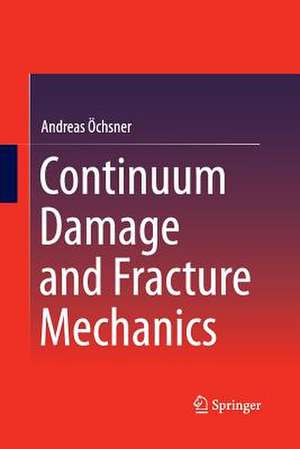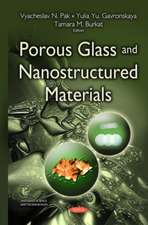Continuum Damage and Fracture Mechanics
Autor Andreas Öchsneren Limba Engleză Paperback – 23 aug 2016
In the first part, the book reviews and expands on the classical theory of elastic and elasto-plastic material behavior. A solid understanding of these two topics is the essential prerequisite to advancing to damage and fracture mechanics. Thus, the second part of this course provides an introduction to the treatment of damage and fractures in the context of applied mechanics
Wherever possible, the one-dimensional case is first introduced and then generalized in a following step. This departs somewhat from the more classical approach, where first the most general case is derived and then simplified to special cases. In general, the required mathematics background is kept to a minimum
Tutorials are included at the end of each chapter, presenting the major steps for the solution and offering valuable tips and tricks. The supplementary problems featured in the book
| Toate formatele și edițiile | Preț | Express |
|---|---|---|
| Paperback (1) | 465.66 lei 6-8 săpt. | |
| Springer Nature Singapore – 23 aug 2016 | 465.66 lei 6-8 săpt. | |
| Hardback (1) | 499.92 lei 6-8 săpt. | |
| Springer Nature Singapore – 24 oct 2015 | 499.92 lei 6-8 săpt. |
Preț: 465.66 lei
Preț vechi: 547.84 lei
-15% Nou
Puncte Express: 698
Preț estimativ în valută:
89.10€ • 93.28$ • 73.73£
89.10€ • 93.28$ • 73.73£
Carte tipărită la comandă
Livrare economică 05-19 aprilie
Preluare comenzi: 021 569.72.76
Specificații
ISBN-13: 9789811013232
ISBN-10: 9811013233
Pagini: 163
Ilustrații: XVIII, 163 p. 133 illus. in color.
Dimensiuni: 155 x 235 mm
Greutate: 0.27 kg
Ediția:Softcover reprint of the original 1st ed. 2016
Editura: Springer Nature Singapore
Colecția Springer
Locul publicării:Singapore, Singapore
ISBN-10: 9811013233
Pagini: 163
Ilustrații: XVIII, 163 p. 133 illus. in color.
Dimensiuni: 155 x 235 mm
Greutate: 0.27 kg
Ediția:Softcover reprint of the original 1st ed. 2016
Editura: Springer Nature Singapore
Colecția Springer
Locul publicării:Singapore, Singapore
Cuprins
Introduction.- Elastic Material Behavior.- Elasto-Plastic Material Behavior.- Continuum Damage Mechanics.- Fracture Mechanics.
Recenzii
“This book is a well-condensed, useful textbook that introduces damage mechanics and fracture mechanics. … The author has succeeded in accomplishing the scope and organizing the content in a very readable structure without losing any important information on this topic. … This book will be useful not only to students, but also junior engineers who frequently utilize these principles. I recommend this book without reservation to anyone who needs to learn fracture mechanics.” (Yan Hong, MRS Bulletin, Vol. 41, September, 2016)
Notă biografică
Andreas Öchsner is Full Professor in the School of Engineering at Griffith University, Australia and Leader of the Mechanical Engineering Program (Head of Discipline and Program Director). Having obtained a Diploma Degree Dipl.-Ing.) in Aeronautical Engineering at the University of Stuttgart (1997), Germany, he spent the time from 1997-2003 at the University of Erlangen-Nuremberg as a research and teaching assistant to obtain his Doctor of Engineering Sciences (Dr.-Ing.). From 2003-2006, he worked as Assistant Professor in the Department of Mechanical Engineering and Head of the Cellular Metals Group affiliated with the University of Aveiro, Portugal. He spent seven years (2007-2013) as Full Professor in the Department of Applied Mechanics at the Technical University of Malaysia - UTM, Malaysia and Head of the Advanced Materials and Structure Lab.
His research interests are related to experimental and computational mechanics, cellular metals and thin structures and interphases.He has published over 370 scientific publications, comprising 13 research monographs, 15 book chapters and three teaching books on the finite element methods. He is the general chairman of eight international conferences on computational and experimental engineering (ACE-X series) and 11 international conferences in the area of heat and mass transfer (DSL series). His editorial work comprises appointments as Editor-in-chief of the international journal Continuum Mechanics and Thermodynamics (Springer), Editor-in-chief of the Springer book series on Advanced Structured Materials and Editor of SpringerBriefs in Applied Sciences and Technology: Computational Mechanics. His research activities were recognised in 2010 by the award of a higher doctorate degree (D.Sc.) by the University of Newcastle, Australia.
His research interests are related to experimental and computational mechanics, cellular metals and thin structures and interphases.He has published over 370 scientific publications, comprising 13 research monographs, 15 book chapters and three teaching books on the finite element methods. He is the general chairman of eight international conferences on computational and experimental engineering (ACE-X series) and 11 international conferences in the area of heat and mass transfer (DSL series). His editorial work comprises appointments as Editor-in-chief of the international journal Continuum Mechanics and Thermodynamics (Springer), Editor-in-chief of the Springer book series on Advanced Structured Materials and Editor of SpringerBriefs in Applied Sciences and Technology: Computational Mechanics. His research activities were recognised in 2010 by the award of a higher doctorate degree (D.Sc.) by the University of Newcastle, Australia.
Textul de pe ultima copertă
This textbook offers readers an introduction to damage and fracture mechanics, equipping them to grasp the basic ideas of the presented approaches to modeling in applied mechanics.
In the first part, the book reviews and expands on the classical theory of elastic and elasto-plastic material behavior. A solid understanding of these two topics is the essential prerequisite to advancing to damage and fracture mechanics. Thus, the second part of this course provides an introduction to the treatment of damage and fractures in the context of applied mechanics.
Wherever possible, the one-dimensional case is first introduced and then generalized in a following step. This departs somewhat from the more classical approach, where first the most general case is derived and then simplified to special cases. In general, the required mathematics background is kept to a minimum.
Tutorials are included at the end of each chapter, presenting the major steps for thesolution and offering valuable tips and tricks. The supplementary problems featured in the book.
In the first part, the book reviews and expands on the classical theory of elastic and elasto-plastic material behavior. A solid understanding of these two topics is the essential prerequisite to advancing to damage and fracture mechanics. Thus, the second part of this course provides an introduction to the treatment of damage and fractures in the context of applied mechanics.
Wherever possible, the one-dimensional case is first introduced and then generalized in a following step. This departs somewhat from the more classical approach, where first the most general case is derived and then simplified to special cases. In general, the required mathematics background is kept to a minimum.
Tutorials are included at the end of each chapter, presenting the major steps for thesolution and offering valuable tips and tricks. The supplementary problems featured in the book.
Caracteristici
Offers a first introduction to the treatment of damage and fractures Enables readers to grasp the basic ideas behind the presented approaches to modeling in applied mechanics Includes worked-out examples to facilitate reader understanding Includes supplementary material: sn.pub/extras









